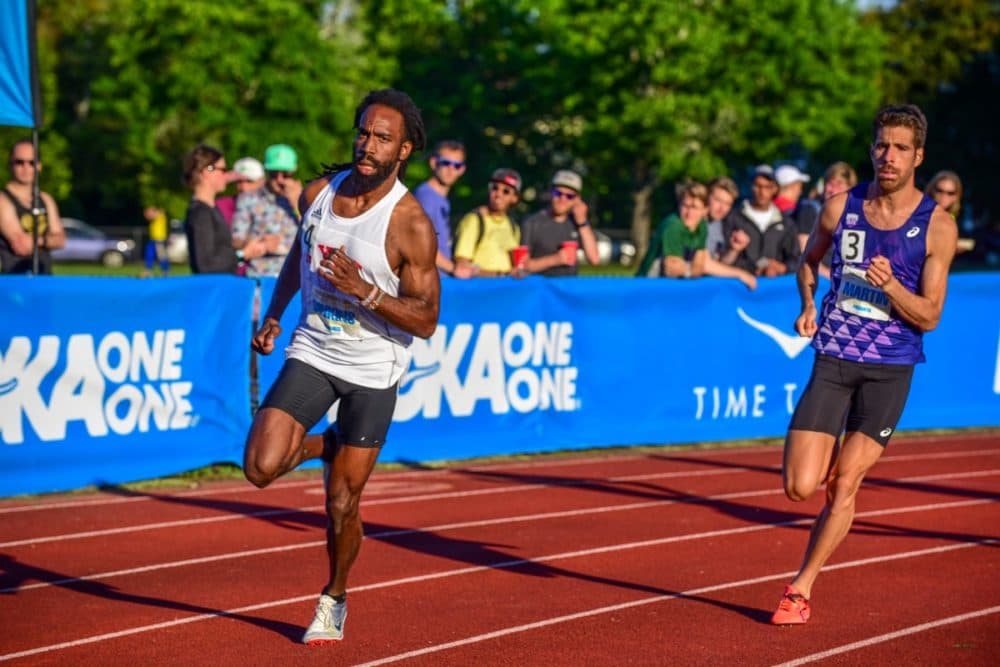Advertisement
'Accelerating Their Advantage': How White Students Use College Sports To Get (Further) Ahead
Resume
This piece is part of our special 6/27/20 episode "Sports, Racism And The Myth Of Meritocracy." Check out the full show here.
Not long after starting at Princeton in 2009, Russell Dinkins knew he’d entered a very different culture.
"The first weekend on campus, after classes start, Princeton has something called lawn parties," he says. "They have some sort of big concert, a bunch of different musical performances and things like that."
What stood out to Dinkins was what his new classmates were wearing.
"[I] saw all these people walking around with pastel-colored everything. You know, boat shoes," he says. "And I was like, 'What is this?' I didn’t even know what Sperrys were. I’m like, 'What are these things people are wearing?' ”
Other incoming freshmen seemed to already know the dress code.
"I thought, 'OK, maybe I should dress like that.' I looked at my closet — I didn’t have anything that looked remotely anything like that," he says. "So I purposefully remember wearing sweatpants and black Air Forces. I definitely felt as if I was being defiant — because I was. But also it was just an act of preservation, because I didn’t have those clothes.”
A Good Story
Dinkins grew up in inner city Philadelphia.
"Just a pretty quiet, regular working class, majority Black neighborhood," he says. "It's a lot of, you know, mamas and daddies, you know, getting on the bus to go to work."
Dinkins was mostly raised by his mom. And, in a lot of ways, his story fits a narrative people like to believe about sports in America.
Because Dinkins ran track, and he was good — good enough that Princeton wanted him.
"I didn't think that I was capable of going to the Ivy league," he says. "I was really looking at schools with a lower academic profile, until Princeton called me and said, 'No, your grades are good. You're running well. We want you.' And that made me go, 'Oh, my gosh, Princeton? Are you kid— ? I can go there?' So that was transformative for me — you know, life-altering."
It’s a story — sports as a vehicle for upward social mobility — that we get fed in movies. We hear it in music.
It’s a story the NCAA itself loves to promote.
"It's not about where you were born ... or the color of your skin," a 2017 NCAA "PSA" declares. "If you have the skill and drive to succeed in school and in sports, we’ll provide the opportunity."
But when Russell Dinkins got to Princeton, he didn’t find a lot of other athletes who looked like him.
"Looking back on it, yeah, most of the athletes were white," he says. "Even our basketball team was pretty white, which is, kind of, really hilarious."
The Truth
The whiteness of college athletics isn’t unique to Princeton — or even the Ivy League.
"We know across Divisions I, II and III, about 72% of college athletes who are women are white, and then, in terms of men, 64% are white," says the University of Oklahoma's Dr. Kirsten Hextrum.
Hextrum, who studies race and college sports, says those numbers are likely underestimates, because they only take into account scholarship athletes.
"Because we see Black men represented in two of the most visible sports — i.e. basketball and football — it disguises the fact that the remaining 38 sports that are sponsored by the NCAA are predominantly played by white and middle class athletes."
Colleges, and especially elite colleges, offer a number of varsity sports you probably won’t find in public school gym class: there’s golf, skiing, fencing, lacrosse, water polo, field hockey, sailing, squash, lightweight and heavyweight crew.
"These kinds of sports aren’t really accessible to people without a certain amount of means," Russell Dinkins says.
"One of the ways we could think about this is that people who grow up in white, middle-class communities are accelerating their advantage by pursuing sports."
Kirsten Hextrum
This has serious consequences, because elite colleges reserve coveted admissions spots for athletic recruits. And it’s not an insignificant number of spots. According to The Harvard Crimson, more than 10% of Harvard's Class of 2020 is made up of recruited athletes. Approximately 13% of Yale's class each year is athletic recruits, according to The Washington Post. At smaller liberal arts colleges, that percentage is likely even greater. (For instance, The Washington Post reports that 25% of Davidson College's class goes to recruited athletes.)
In 2018, The Atlantic put it like this: “College Sports Are Affirmative Action for Rich White Students.”
"White and middle class communities have intentionally and explicitly over time sought out sports to advantage themselves in the college-going process," Hextrum says. "One of the ways we could think about this is that people who grow up in white, middle class communities are accelerating their advantage by pursuing sports."
Kirsten Hextrum says there are really just four NCAA sports that draw a significant number of athletes of color: basketball, football, baseball, and track and field.
Which brings us to just a few weeks ago.
'Please Make It Make Sense'
In late May, Russell Dinkins — who, since graduating from Princeton in 2013, has worked in education and in diversity and inclusion — learned that Brown University was cutting its men’s track and field team.
"I remember being very upset. But, for some reason, I wanted to believe that there had to be some reason for this decision," Dinkins recalls. "I was hoping that I was going to go to the school’s website and I was going to read their decision and say, 'OK, this makes sense.' I was just hoping. I'm like, 'Please make it make sense.' "
The university was cutting 11 varsity teams, including men’s track and field, and also elevating sailing to varsity status.
Brown President Christina Paxson said the school wanted to make its sports teams more competitive.
"This is a strategic initiative to redistribute resources to elevate the excellence of varsity and club sports at Brown," she said in a video posted on the school's website.
She also said the move “aligns with our diversity and inclusion efforts, expanding opportunities in competitive club sports.”
"Then I got angry," Dinkins says, "then I got mad. Because not only were the arguments nonsensical in my view, but they also were misleading. The way that it’s being presented makes it seem like club and varsity are at the same level. And club teams do not get funding from the university in a major way, and they also don’t get recruiting spots."
Dinkins knew that if men’s track and field was no longer a varsity team, there would be even fewer of those coveted recruiting spots for sports often played by people of color.
"I went on to Brown's website and then counted the number of Black guys that are on the roster for track," he says. "And then I looked up baseball, crew, ice hockey and lacrosse, and there were more Black guys on track and field than all of those other sports combined. Some of those other sports did not have a single Black person. Some of those other sports did not have a single non-white person on them."
Dinkins connected with Brown track alums. They thought the story deserved national attention.
Dinkins decided to write something up.
"I’m a person without a platform," he says. "You know, I think I have 400 followers on Twitter. One, I just wanted to write my ideas out — just get ‘em out."
Dinkins also thought he could send what he wrote to media outlets, in hopes that they’d cover the story themselves.
So he got to work.
"I worked, like, pretty much all day on it," he says. "Part of me, I remember, I was like, 'Why am I working so hard on something no one’s going to read?' "
Dinkins wrote, in part:
By cutting Track and Field, Brown is literally taking away admissions opportunities for Black male athletes while preserving admission opportunities for white athletes in affluent sports. And to add insult to injury, sailing is being elevated to varsity while track will be reduced to a club team with no recruiting slots. Brown should be finding more opportunities for Black men to go to Brown, not fewer.
"But I posted it at, like, 11 p.m. I woke up in the morning, and I think in the morning I had 1,000 or 2,000 views. And then it just started snowballing."
While Dinkins' article spread, Brown track alums continued working to save the team. And then, 12 days after Brown’s initial announcement, the university said it was reinstating the men’s track and field team.
"And so when I found out, [I was] overjoyed," Dinkins recalls. "I remember I made an Instagram Live, just very emotional."
"You guys know I did not go to Brown," Dinkins says in the video. "But I felt personally impacted by this decision, and I needed to fight for that kid whose name I will never know."
Moving In The Wrong Direction
So the Brown men’s track and field team has been saved. But, when it comes to college sports and racial inequities, University of Oklahoma professor Kirsten Hextrum says we’re actually moving in the wrong direction.
In 2017, ESPN’s The Undefeated published an analysis called “The Gentrification of College Hoops,” which looked at the percentage of Division I college athletes who were first generation college students — i.e. students whose parents did not attend college.
In 2010 that number was just 16.1 percent. By 2015 it had dropped to 14.2 percent.
So, in spite of NCAA “PSAs" about college sports providing opportunity for everyone, the vast majority of its athletes are white, and only a small and seemingly decreasing fraction are first generation college students.
Not exactly the path for upward mobility that many would like to believe.
"I think like many of the gaps — the wealth gap, the racial achievement gaps — these gaps have increased over time in very systematic ways," Hextrum says.
And, even for the Black men and women who are able to use sports as means of upward mobility, inequities persist once they get to campus.
For 25 years, journalist Derrick Z. Jackson has been following the graduation rates of white and Black college football and basketball players.
"You have many football teams where the white graduation rate is 80% and above, whereas the Black graduation rates are more like 50 to 65%," Jackson says.
Jackson believes we need to think much bigger than trying to preserve or create more pathways for young Black men and women to enter college through sports.
"I think we really need to see sports as a very, very checkered pathway — not necessarily negative, but I do think we really have to see it for what it is," he says. "What I mean by that is: for Black people, sports end up being something that they are channeled into after being denied full aspirations for anything else."
This story is part of our special episode "Sports, Racism And The Myth Of Meritocracy."
This segment aired on June 27, 2020.

